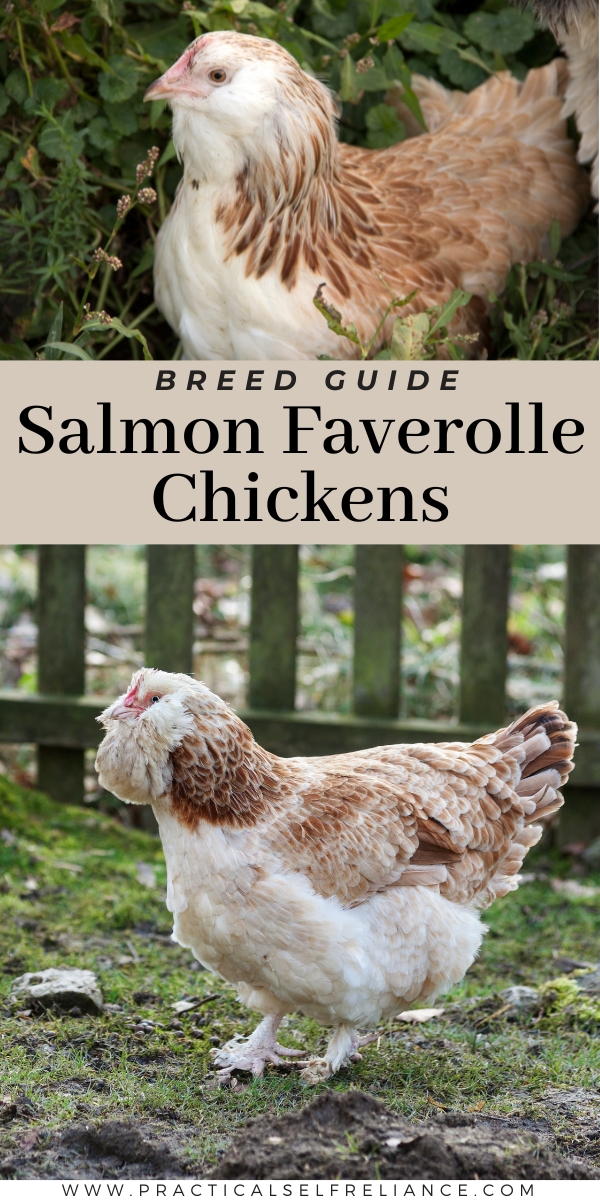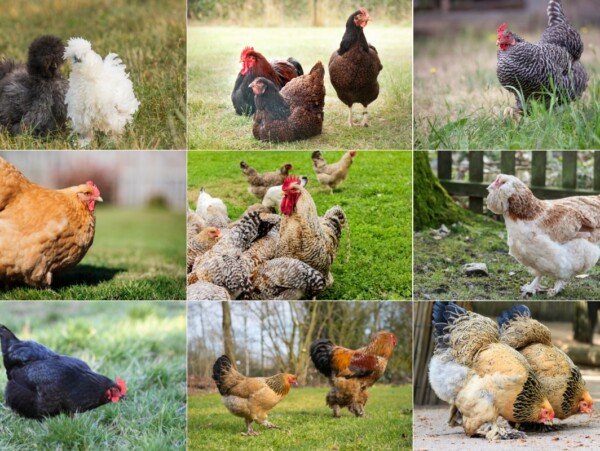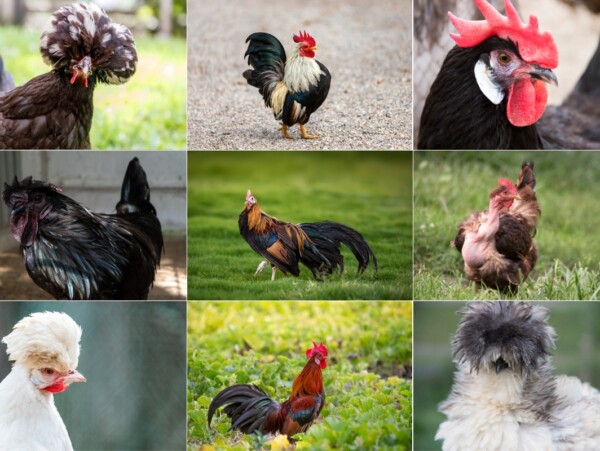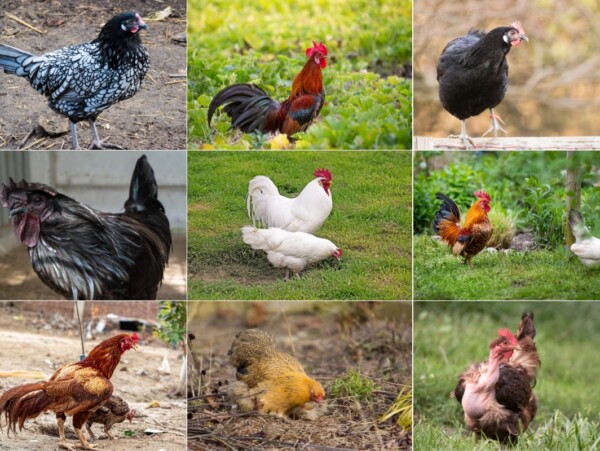Affiliate disclosure: This post may contain affiliate links. Please see our Privacy Policy.
Salmon Faverolles are excellent egg producers that are docile and entertaining to watch. With excellent cold tolerance, they’ll happily lay tinted eggs for you in a small coop or yard all year. They’re a great beginning breed and also make for wonderful pets!
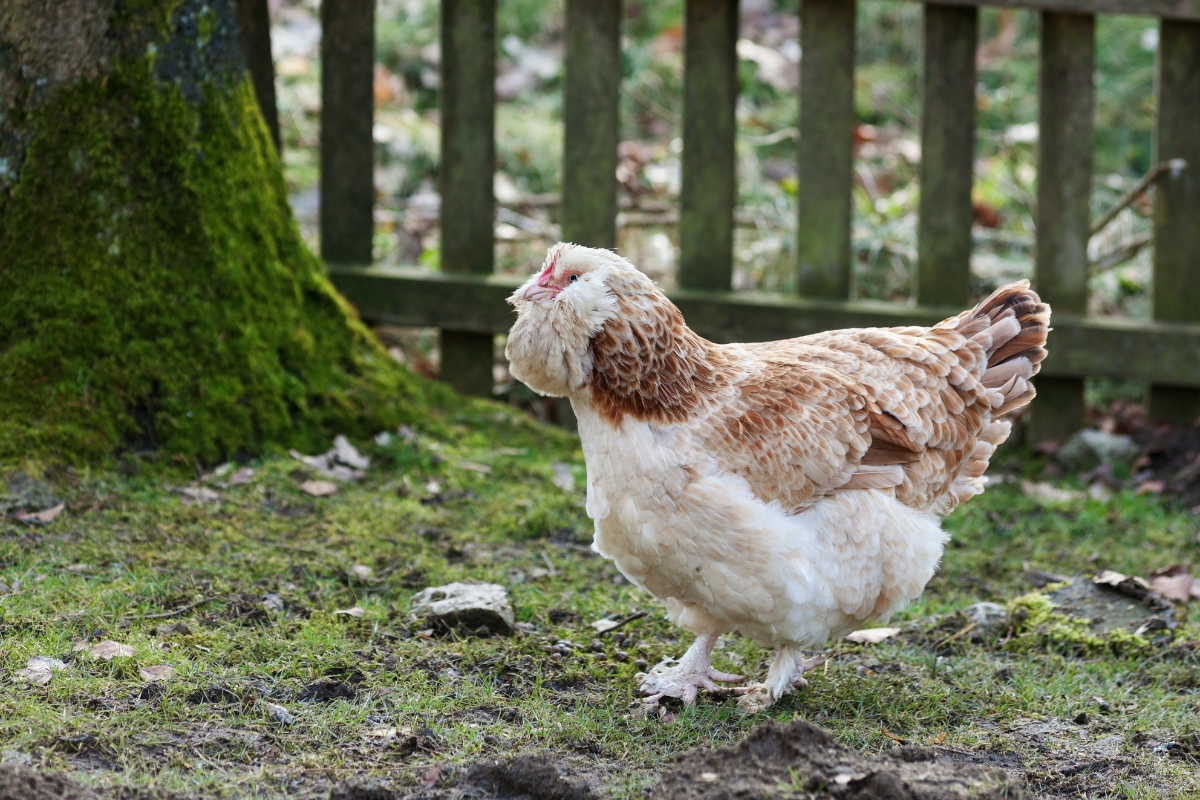
Table of Contents
- What are Salmon Faverolle Chickens?
- Salmon Faverolle Chicken Characteristics
- Salmon Faverolle Breed Standard
- Temperament
- Hardiness
- Egg Production
- Egg Color
- Meat
- Broodiness
- Foraging Ability
- Cross Breeds
- Common Health Issues
- Pros and Cons of Salmon Faverolle Chickens
- Tips for Raising Salmon Faverolle Chickens
- Salmon Faverolle Chicken FAQ
This year we added a number of new chicken breeds to our flock, and salmon faverolles were high on our list of favorites.
Since they’re incredibly cold hardy, they’ll do well in our cold Vermont winters, and their salmon colored eggs add yet another hue to our rainbow egg basket.
Since I have two young kids, friendly docile chicken breeds are a must, and these little fluffy cuties are about as friendly as they come. They’re so friendly, that you actually shouldn’t keep them with many other more “aggressive” chicken breeds.
Luckily our coop is filled with other docile, cold hardy chickens that lay colorful eggs, like Bielefelders and Buff Orpingtons. Salmon Faverolle chickens fit in just fine in this mixed flock of friendly, hardy chickens.
What are Salmon Faverolle Chickens?
Salmon Faverolles have been a standard breed in North America since 1914. Originally, they were bred in the town of Faverolle (recognize the name?) just south of Paris. In 1860 chicken farmers in the town began crossing French Rennes, Dorkings, Houdans, Flemish Cuckoos, and Malines. Farmers at the time wanted a bird that handled captivity well, produced eggs through the winter, and was large enough to sell for meat.
While the farmers were successful, they also unintentionally bred a beautiful bird with unique coloring. Baby chicks are creamy white and very fluffy. Around 3-5 weeks old the males will begin to show black on their chest, then develop dark feathers on their belly and tail. The hens will stay lighter and show brown and salmon markings on their breast.
Both sexes have a neat single comb with five points, feathered legs, and fluffy cheeks.
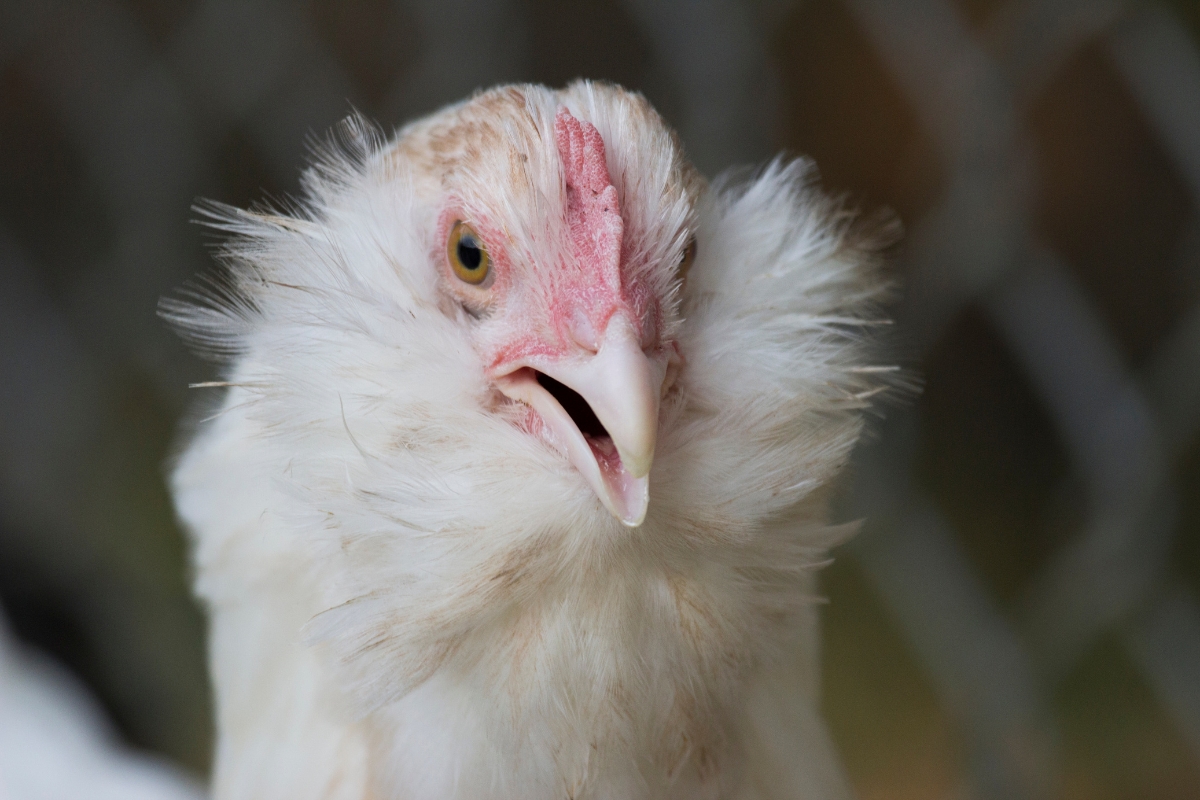
Salmon Faverolle Chicken Characteristics
Easy to raise and even easier to watch, Salmon Faverolles are an entertaining breed to have in your yard. Energetic birds, they’ll dart around bumping into one another, chatting all the while. The birds are very friendly and so docile they won’t stand up for themselves against any yard bullies.
Salmon Faverolles are excellent egg layers and handle cold weather with ease. This is thanks to their fluffy feathers which make them look bigger than they are. Males get up to 8 pounds while females are a bit lighter. They mature more quickly than other heritage breeds at about 19 weeks.
- Breed Name: Salmon Faverolle (pronounced SAH-MAN FAV-ROLL)
- Breed Type: Standard for eggs, meat, and ornamentation
- Temperament: Docile and active, most enjoy being lap-chickens
- Size: Medium to Large; roosters average 8 pounds and hens 6 ½ pounds
- Eggs Per Year: 180 to 240
- Egg Size: Medium
- Egg Color: Light brown to cream
- Lifespan: 5 to 7 years
- Time To Maturity: 19 weeks
Salmon Faverolle Breed Standard
A rarity, you’ll notice the Salmon Faverolle has five toes and they’re all feathered. Wide bodied and almost trapezoidal in shape, this breed carries itself low to the ground. Most well known for its fluffy appearance, they have a wide muff, long beards, and feathered legs. Their wattles are almost not there and their earlobes are small.
Chicks from Salmon Faverolles are not autosexing and you won’t be able to tell the sexes apart for 3-5 weeks.
Mature roosters have a straw-colored head and back. Their tails and bellies will be black with some iridescent green in the tail.
Females stay cream colored and have the salmon-brown coloring as markings on their breasts.
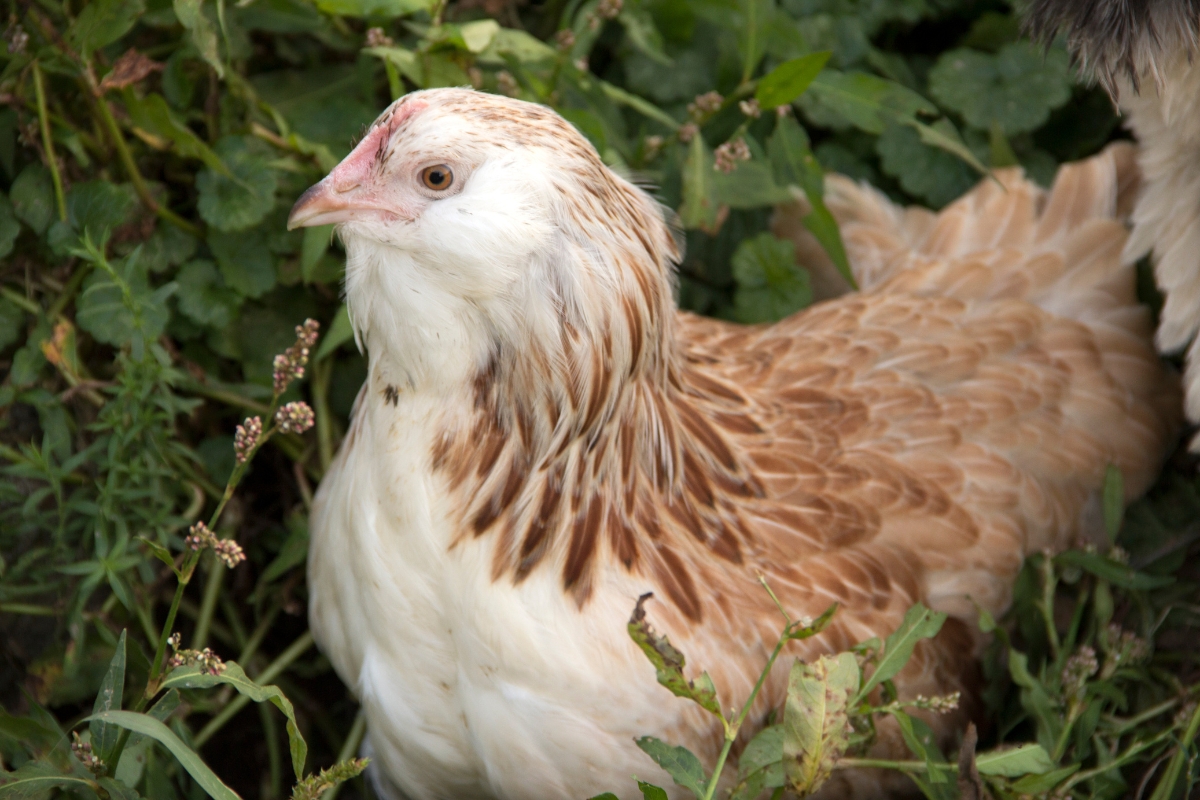
Temperament
Easily swayed by treats, Salmon Faverolles will happily follow you around the yard any time you’re out. These chickens are known for being chatty but aren’t usually loud. Docile as they come, both hens and roosters will let small children pick them up for cuddles. While they enjoy foraging, Salmon Faverolles are particularly suited to enclosures and would make the perfect bird for a small backyard coop.
The roosters in this breed are well known for being calm and docile. To the point that they tend to run from any aggression rather than confront it. For the safety of the birds, it may be best not to place them in mixed flocks.
Hardiness
Salmon Faverolles will do best in colder climates but can tolerate some heat. During the summer months they will need access to plenty of shade and cool water. Winter can be a challenge to these birds if their feet aren’t kept dry; wet feathers on their feet can lead to frostbite.
Egg Production
Most weeks you can expect your hens to lay 3-4 medium-sized eggs. This totals up to about 180 eggs per year, but particularly good layers can bump that number up to 240. Salmon Faverolles were bred to lay during colder months and are early-layers. You can expect eggs from hens just before they turn 20 weeks old.
Egg Color
Lighter brown to cream eggs are typical. The eggs are usually described as being “tinted” and this tint sometimes can have a slight pink, almost salmon hue to it.
Meat
Salmon Faverolles have excellent meat, though to reach table-weight it may take 6-8 months. You may find it a better investment to save on a few weeks of maturing and feed costs in order to enjoy a more tender meat at almost full weight.
Broodiness
Some owners will say this is a broody breed, but others will differ. No matter the report, there’s general consensus they’re easy to break from brooding. If left alone, though, they make excellent mothers to chicks.
Foraging Ability
Get ready for an on-the-go bird! Salmon Faverolles are very active and will enjoy foraging for whatever your yard may offer. Because of their fluffy cheek feathers, they may not always spot predators though they are always on the alert.
Cross Breeds
Having been bred in 1860 there aren’t exact histories for the Salmon Faverolle. Most likely they’re a cross with Houdan, Maline, Dorking, French Rennes, and the Flemish Cuckoo. While you may hear of other standard Faverolles, in North America only the Salmon and White breeds are standardized.
Common Health Issues
Most issues associated with this breed are centered around their abundance of feathers. With feathers extending down their legs and toes, they may pick up some scaly leg mites. You’ll want to routinely check them for both mites and lice, paying close attention to their vents and under their wings.
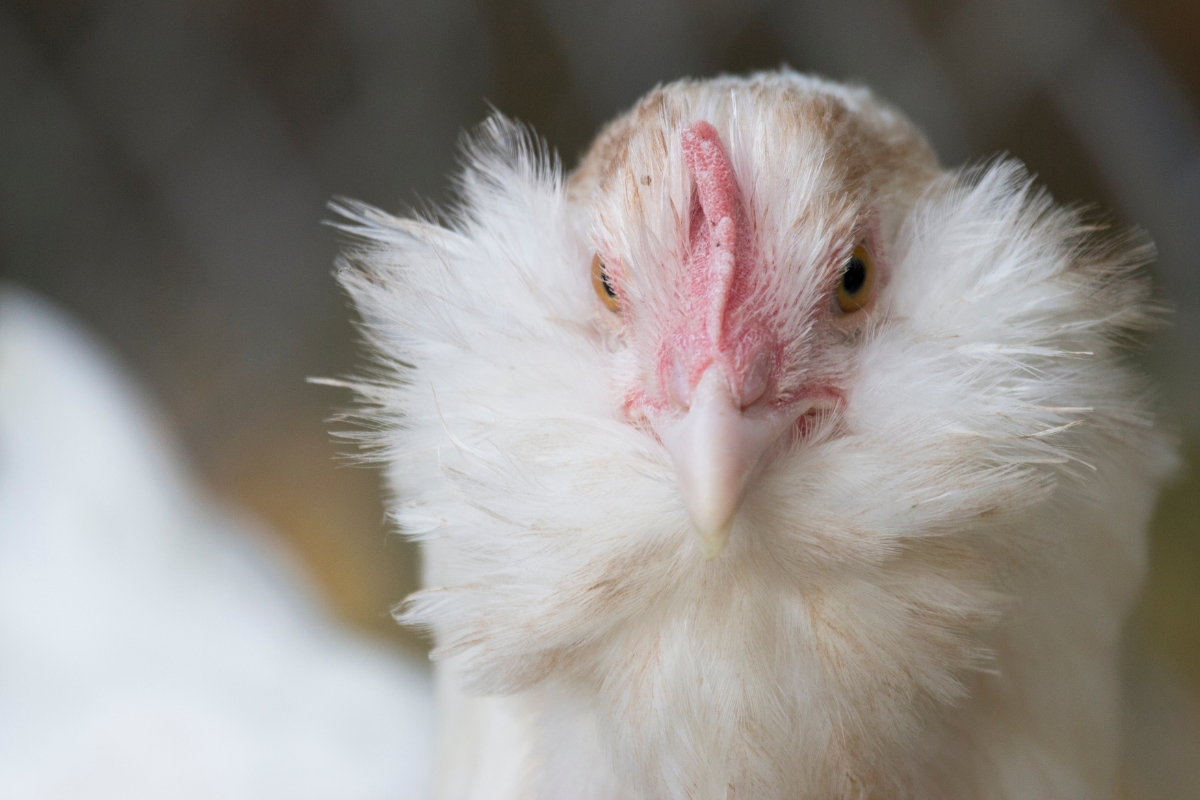
Pros and Cons of Salmon Faverolle Chickens
As a mother with young kids, I’m incredibly excited about this breed, both for it’s friendly, docile disposition and it’s eye catching plumage and egg color. Still, I’ll let you decide if the pros outweigh the cons.
Pros:
- Docile, friendly, and entertaining
- Cold tolerant
- Early layers
- Good egg producers
- Perfect for a small backyard
- Winter eggs
- Tender white meat
Cons:
- Meat toughens quickly as they age
- 6-8 months to reach full weight
- Do not do well around more aggressive birds
- Not very heat or drought tolerant
Tips for Raising Salmon Faverolle Chickens
These chickens are easier for beginners but still require quality nutrition and environments to allow them to produce eggs consistently. While they do well in smaller enclosures, they will still want about 3-4 square feet of roost and 8 feet of run per chicken. Lack of space can lead to feather picking and antisocial behavior.
Happily eating scraps from the house or foraging in the yard, these chickens won’t cost you too much for food. However, because they’re early layers, you’ll want to make sure the chicks have high quality, 20% protein feed until at least 16 weeks.
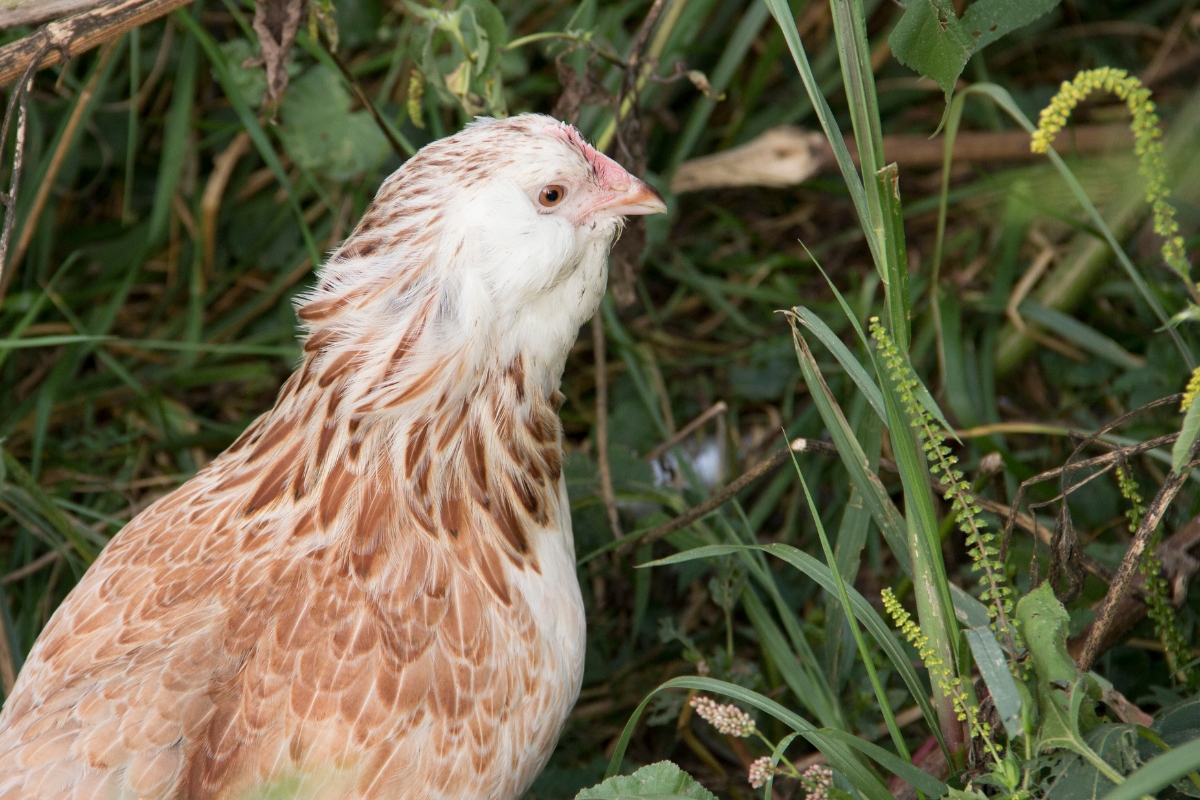
Salmon Faverolle Chicken FAQ
Still looking for some answers? There are some common questions below that will hopefully bring some your way.
Yes! Very friendly and entertaining to watch, you’ll enjoy spending time with them.
Yes, they are great layers. Even the colder months won’t stop them, though it might stall them if they aren’t cared for well. Make sure their nests and roosts are dry and clean.
Typically cream to a light brown. All their eggs will be a bit tinted and some tint may even reach a slight pink color.
Potentially, but hens in this breed are easily broken from this habit if you want. They do make great mothers if you allow their eggs to hatch!
Medium to large, you’ll find roosters about 8 pounds and hens 6 ½ pounds.
Their meat is excellent and very tender. It may be best not to wait until they reach full size at 8 months old, though, as their meat toughens quickly as they age.
No, chicks will look the same after hatching until they are 3-5 weeks old.
Yes, they’re quite cold hardy, but they don’t tolerate heat. They won’t do as well in the heat but can manage with shade and cool water.
On average they will live for 5 to 7 years. You’ll find these chickens are at a good table-weight by 6-8 months old on average. Egg production will begin to drop off after the hens are 3 years old and they’ll soon reach retirement after that.
Yes, particularly in a coop environment where they won’t need to worry about predators in their blind spots. Chicks in the flock are well cared for and both hens and roosters are very docile. As early layers, the young hens will need a higher protein feed than most.
